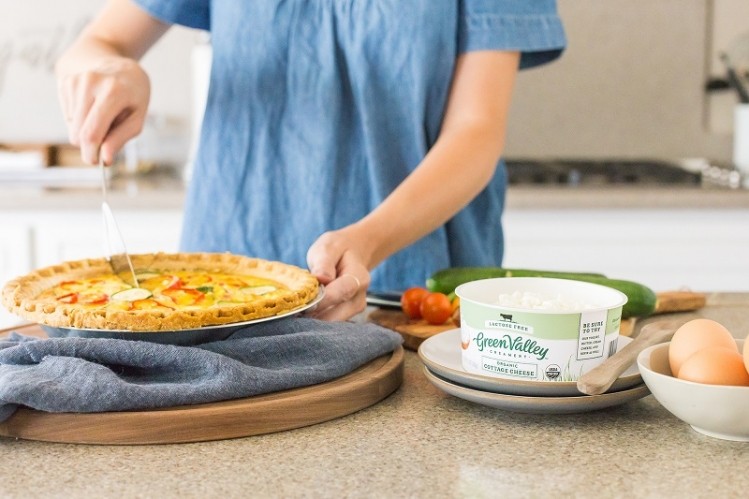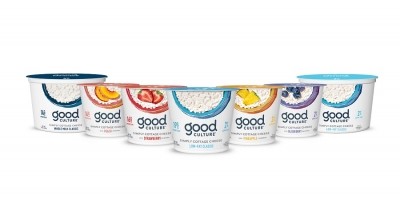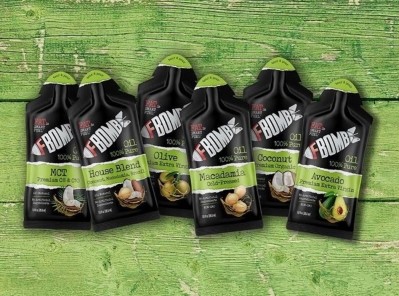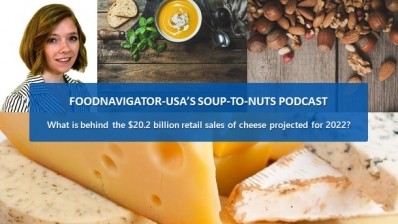Modern updates to cottage cheese could help it steal market share from yogurt

For the past decade yogurt has been a cash-cow for the dairy industry with sales growing 7.8% to 10% year-over-year from 2010 through 2013, according to market analysis from Packaged Facts. But as the years march on, sales slowed to a mere 3.4% from 2013 to 2014 and Packaged Facts adjusted its projected compound annual grown through 2017 to only 2%.
Part of this slowdown is due to a larger base, which makes the same near double-digit increases more difficult. But also competition for on-the-go high protein foods is up, including most recently from cottage cheese thanks to manufacturers, such as Dean Foods and Green Valley Creamery, giving it innovative twists.
“Key market trends – as well as insights from our own Dean Foods’ Executive Insights Report – showed us that snacks are replacing meals and stressed the importance of convenience, high protein and real ingredients,” all of which can be found in cottage cheese, Marissa Jarratt, senior vice president of marketing and innovations at Dean Foods, told FoodNavigator-USA.
At the same time, she added, “we saw there was a perception of cottage cheese as an old-fashioned food and a lack of emphasis on its health benefits. Also, the category itself has suffered from a lack of innovation, something that younger generations are craving in their food decision making.”
Jarratt explained that Dean Foods saw this disconnect as “the perfect ‘white space’ to take a classic snack and add a twist to make it exciting again.”
The company’s DairyPure Mix-ins, which are regionally available nationwide, do just that by combining fruit, nuts and cottage cheese in portable 5.3 ounce cups. The line currently includes four flavors – blueberry, peach & pecan, pineapple and strawberry & almond – but Jarratt expects additional flavors to launch in the future.
“By ‘mixing in the good stuff,’ we are adding flavor and personality to our product and giving consumers more variety and ultimately, more reasons to reengage with cottage cheese,” Jarratt said. “Our Mix-ins innovation, which we will expand in coming years, may also help offset a flattening yogurt category, as Millennial consumers seek out better-for-you and more convenient snacking options.”
She explained: “We’ve tapped into the portability and flavors that draw many younger, more Millennial-minded shoppers to the yogurt aisle. Our single-serving containers are convenient for eating at or away from home, and the choice of four fresh fruit and nut toppings – which sets itself apart from the many decadent alternatives – delivers on the variety shoppers want.”
She added cottage cheese also could steal market share from yogurt by offering more protein than regular yogurt. DairyPure Mix-ins offer more than 15 grams of protein per container and are made from non-GMO ingredients with no artificial sweeteners or growth hormones, she said.
While there undeniably is room for growth, DairyPure Mix-ins is not alone in the updated cottage cheese category. Early front-runners include Good Culture and Muuna, both of which also offer on-the-go single-serve containers that blend cottage cheese with fruit and savory ingredients.
Green Valley Creamery offers lactose-free option
Another newcomer to the category is Green Valley Creamery, which is setting itself apart in the increasingly crowded space by offering a lactose-free, FODMAP-friendly organic cottage cheese.
This month the company, formerly Green Valley Organics, launched its lactose-free cottage cheese in 12-ounce cups for a suggested retail price of $5.29 as an extension of its larger lactose-free portfolio of yogurt, kefier, sour cream and cream cheese.
“There are millions of Americans that have more or less given up on dairy because of their lactose sensitivity or intolerance and they just miss it,” Rich Martin, VP of sales and marketing for Green Valley Creamery, told FoodNavigator-USA.
He explained that the company added cottage cheese to its line up of lactose-free foods because “we just kept seeing more and more and more consumers ask about cottage cheese.”
He hypothesized their interest in the product stems in part from their desire to eat higher protein, lower-carb and lower-sugar products and that cottage cheese easily fits into different day parts and eating occasions either as the base for a sweet or savory snack or as an ingredient in a main dish.
He also said consumers are coming back to cottage cheese after decades of either not consuming it or doing so infrequently because it tastes better than it used to.
“Cottage cheese is kind of like Brussels sprouts. I was a kid in the ’70s and I remember desperately trying to avoid cottage cheese the same way that I tried to avoid my mom’s idea of Brussels sprouts, which was god-awful overcooked. But now I would eat Brussels sprouts every night if I could and that is because of how they are prepared – and the same goes for cottage cheese,” he said.
“We are one of the cottage cheeses that tastes better because it doesn’t have any gums or thickeners. There is no guar gum. There is no carrageenan. There is no xanthan gum or any of those things. There is no lactic acid. So, it just has a cleaner taste, and I think that is really contributing to its rising popularity,” he said.
Cottage cheese's old-fashioned image is a major barrier
While cottage cheese has significant potential, it also has barriers it needs to overcome before it can maximize its impact.
Top among these is the ingredient’s old-fashioned image, Martin said.
“For as many people who are embracing cottage cheese, there are still tons of people who have that yucky 1970's association with it and remember hating it,” he explained.
To overcome this, Green Valley Creamery is trying to spur trial through demonstrations and word of mouth on social media. It also is sharing different recipes with the hope that “one will push someone over the edge to try it as long as there are other ingredients in the recipe they really like,” he said.
Dean Foods also will drive trail of younger consumers, some of whom may have shunned the category previously, by playing up its nutritional benefits in a “holistic and integrated marketing campaign” that will begin in 2018 and continue into early 2019.
The “fun and engaging new digital ad creative campaign” will included in-store shopper promotions, social media content and “robust earned media and influencer programs,” Jarratt said. It also will “help bring to life the nutritional benefits of eating cottage cheese for a younger generation, as well as the innovative varieties Mix-ins delivers that helps them maintain their active lifestyle.”
















